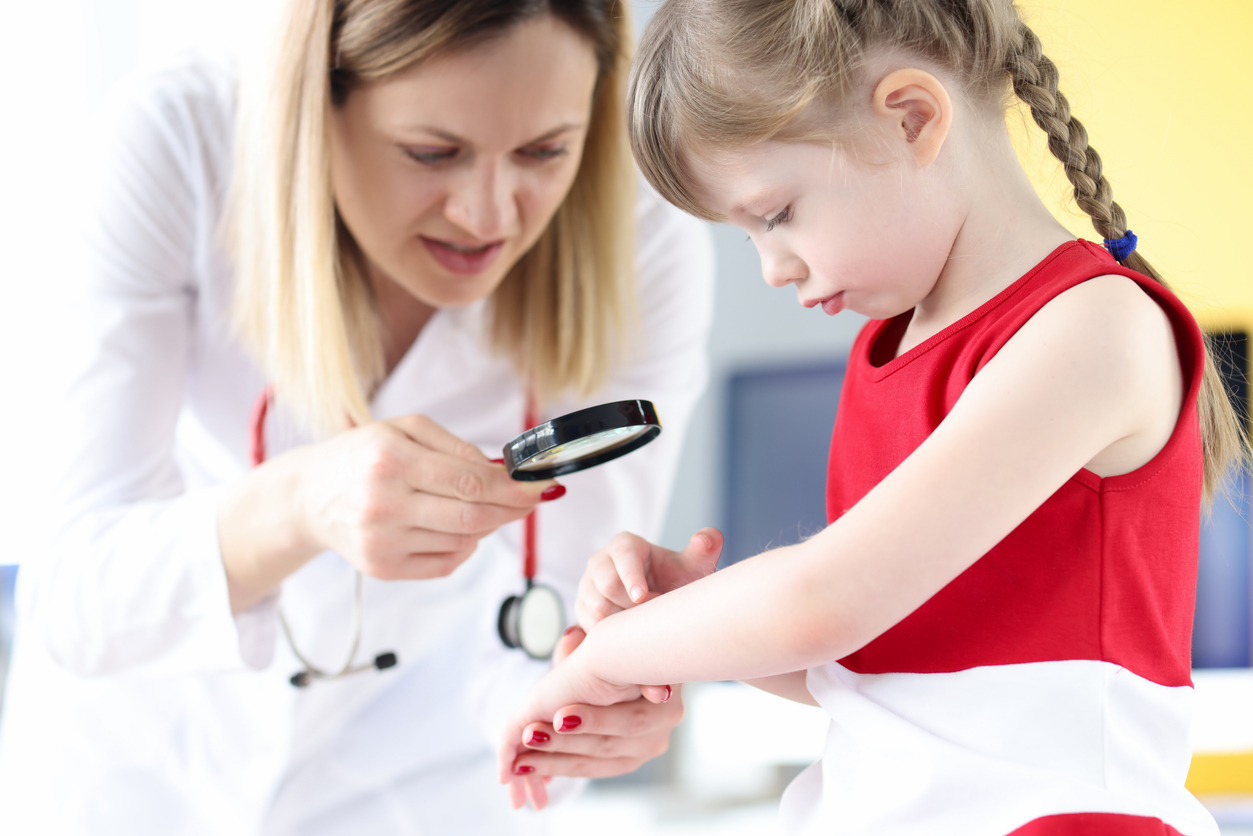Even for adults, it can be puzzling to understand the cause of and treatments for sudden or chronic skin conditions. This anxiety is even worse when unknown skin conditions affect our young children. Their delicate skin is more susceptible to various irritants and infections, leading to a wide range of uncomfortable and sometimes concerning symptoms.
In this blog, let’s explore the most common pediatric skin concerns and their treatments, walking you through the many forms of dermatitis, viral infections, bacterial infections, and fungal infections, equipping parents with the knowledge to confidently navigate these challenges and ensure the well-being of their children’s skin.
1. Atopic Dermatitis (Eczema)
Atopic dermatitis, commonly known as eczema, is a chronic inflammatory skin condition that often begins in infancy or early childhood. It’s characterized by itchy, red, and inflamed skin that can crack and ooze.
Eczema is often associated with allergies and genetics and can be triggered by irritants or allergens. Symptoms include intense itching, dry, scaly skin, red patches, and sometimes even thickened skin.
Treatment for Atopic Dermatitis
Treatment for eczema focuses on managing symptoms and preventing flare-ups. This may include moisturizing regularly with fragrance-free emollients, using topical corticosteroids to reduce inflammation, and taking antihistamines to relieve itching. In severe cases, immunosuppressant medications may be prescribed.
2. Contact Dermatitis
Contact dermatitis is like your skin’s way of saying “ouch!” when it comes into contact with something it doesn’t agree with. This skin inflammation can be triggered by two main culprits: irritants and allergens.
Irritants, like harsh soaps or certain chemicals, can directly damage the skin’s protective barrier, leading to redness and irritation. On the other hand, allergens, such as nickel in jewelry, poison ivy, or even latex, trigger an allergic reaction, causing the immune system to go into overdrive. This immune response can result in a range of symptoms, from a simple red rash to more severe reactions with itching, swelling, and even blistering.
Treatment for Contact Dermatitis
The good news is that managing contact dermatitis often involves a simple solution: avoidance. Identifying and steering clear of the offending substance is key. For those irritants, switching to gentler products can make a big difference. When it comes to allergens, a little detective work may be needed to pinpoint the cause. In the meantime, soothing the irritated skin with cool compresses and using topical corticosteroids can provide much-needed relief.
3. Diaper Rash
Diaper rash is a common and often frustrating experience for parents. This skin irritation occurs in the delicate diaper area and can leave your little one uncomfortable and fussy. Prolonged exposure to moisture, urine, and stool can irritate the sensitive skin, leading to redness and soreness. In some cases, yeast can also thrive in the moist environment, making the rash worse.
Treatment for Diaper Rash
Fortunately, there are simple steps you can take to soothe and prevent this uncomfortable condition, such as:
- Frequent diaper changes: This is key to keeping the diaper area dry and reducing irritation.
- Airtime: Allowing your baby’s bottom some airtime helps to dry the area and prevent further moisture buildup.
- Barrier creams: Applying a barrier cream like zinc oxide creates a protective layer on the skin, shielding it from moisture and irritants.
- Antifungal creams: In cases where yeast is causing the diaper rash, antifungal creams can effectively treat the infection.
4. Viral Infections
Picture this: your child suddenly develops a fever and starts feeling achy. Then, itchy, fluid-filled blisters begin to erupt all over their body. This is the dreaded chickenpox, caused by the varicella-zoster virus. While it can be uncomfortable, chickenpox is usually a mild childhood illness. Besides the telltale blisters, children may experience fever, fatigue, and a loss of appetite.
Treatment for Viral Infections
The key is to keep them comfortable during this time. Over-the-counter medications can help manage fever and itching, and soothing calamine lotion can provide some relief from the itchy blisters.
5. Bacterial Infections
Impetigo
Bacterial skin infections can be a real nuisance for children. Impetigo, for example, is a highly contagious infection that often appears as red sores around the nose and mouth. These sores may ooze pus and then form a crusty, honey-colored scab.
Treatment for Impetigo
It’s important to keep the affected area clean to prevent the spread of the infection, and antibiotics are usually needed to clear it up.
Folliculitis
Another common bacterial skin infection is folliculitis: tiny, red bumps around the hair follicles that occur when the hair follicles become inflamed.
Treatment for Folliculitis
While usually not serious, it can be uncomfortable and may require treatment with antibiotics. Keeping the affected area clean and dry is crucial to prevent further irritation.
6. Fungal Infections
Ringworm
Fungal infections can be tricky to deal with, but luckily, they are usually treatable. Ringworm, for example, is a fungal infection that causes a distinctive circular rash, often with a red, scaly border. It can appear on the skin, scalp, or even the feet, and can be quite itchy.
Treatment for Ringworm
Thankfully, antifungal creams or oral medications can effectively clear up the infection.
Candidiasis
Another common fungal infection is candidiasis, often referred to as a yeast infection. This can occur in the mouth, causing a condition known as thrush, or in the diaper area. You might notice white, creamy patches in these areas.
Treatment for Candidiasis
Antifungal medications are typically used to treat candidiasis.
When to See a Pediatric Dermatologist
Knowing when to seek professional help for your child’s skin can make a significant difference in their comfort and overall health. If you notice any of the following, it’s time to consult with a pediatric dermatologist:
- Persistent Troubles: If your child’s skin condition persists despite your best home care efforts, it’s time to call in the experts like those at Skin MD.
- Worrying Signs: If a skin infection seems to be spreading rapidly or worsening, or if you notice any unusual or concerning skin changes, such as new skin growths or discoloration, don’t hesitate to seek professional guidance.
- Skin Concerns: Any concerns you have about your child’s skin’s appearance or health warrant a visit to a pediatric dermatologist. They have the expertise to assess the situation and provide the best course of action.
- Suspected Allergies: If you suspect your child may have allergies or sensitivities that are affecting their skin, a pediatric dermatologist can help pinpoint the triggers and develop a management plan.
Your child’s skin health is important. Don’t hesitate to seek help from a pediatric dermatologist when needed. Early intervention can often lead to quicker resolution and minimize discomfort for your child.
Schedule Your Child’s Skin Evaluation at Skin MD
Witnessing your child’s discomfort with skin issues can be incredibly distressing. You want the best for them, and that includes healthy, happy skin.
At Skin MD, our pediatric dermatologists’ focus lies in providing the compassionate and personalized care your child deserves. We offer a wide range of diagnostic and treatment options to address a variety of skin conditions, from the familiar itch of eczema to more complex concerns.
We believe in building strong partnerships with families, offering support and guidance from diagnosis to recovery. Schedule a consultation today in one of our several Chicago locations, and let us help your child feel their best in 2025.



